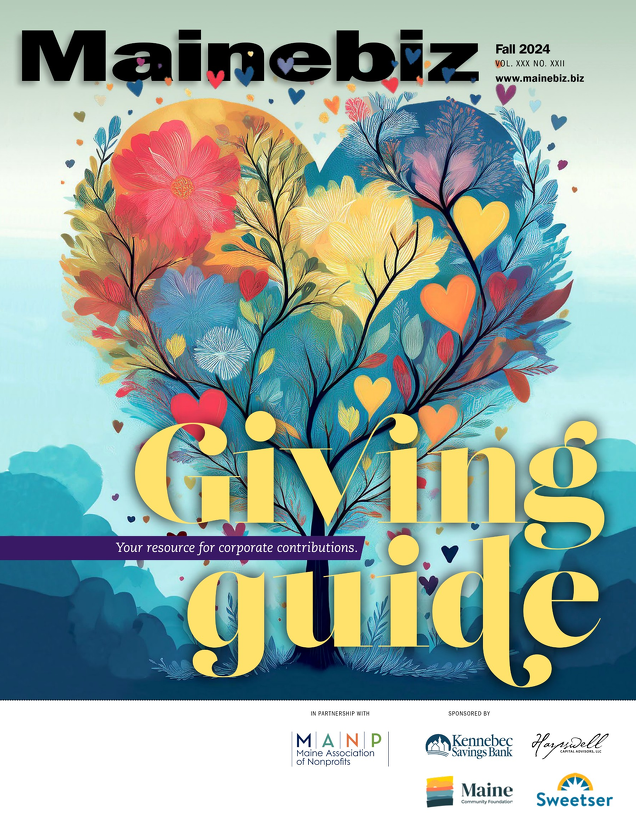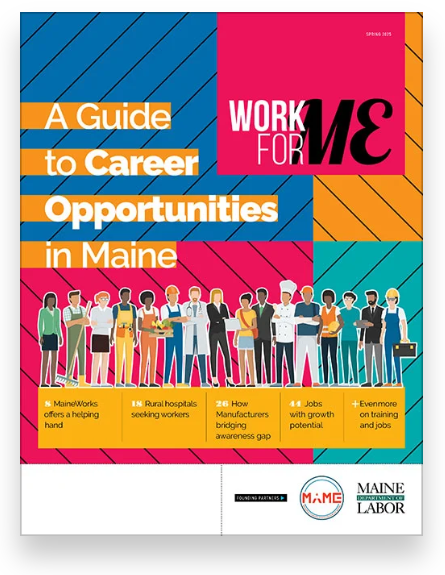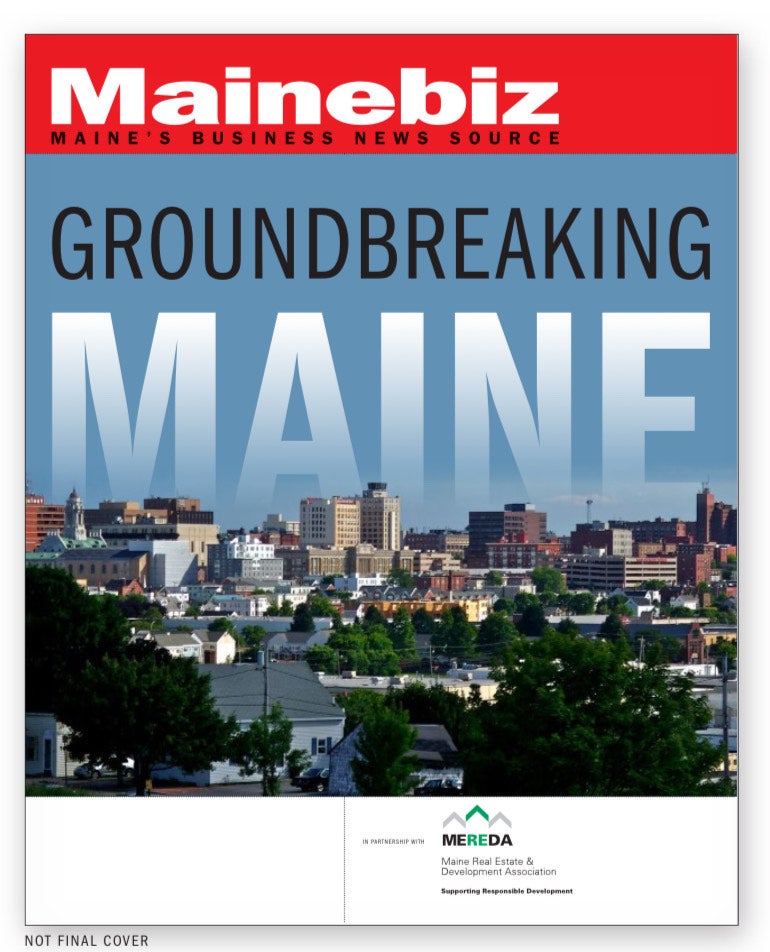
Processing Your Payment
Please do not leave this page until complete. This can take a few moments.
- News
-
Editions
-
- Lists
-
Viewpoints
-
Our Events
-
Award Honorees
- 2025 Business Leaders of the Year
- 2025 Outstanding Women in Business
- 2024 Women to Watch Honorees
- 2024 Business Leaders of the Year
- 2023 NextUp: 40 Under 40 Honorees
- 2023 Women to Watch Honorees
- 2023 Business Leaders of the Year
- 2022 NextUp: 40 Under 40 Honorees
- 2022 Women to Watch Honorees
- 2022 Business Leaders of the Year
-
-
Calendar
-
Biz Marketplace
- News
-
Editions
View Digital Editions
Biweekly Issues
- September 22, 2025
- September 8, 2025
- August 25, 2025
- August 11, 2025
- July 28, 2025
- July 14, 2025
- + More
Special Editions
- Lists
- Viewpoints
-
Our Events
Event Info
- View all Events
- On The Road with Mainebiz in Bath
- 60 Ideas in 60 Minutes Portland 2025
- 40 Under 40 Awards Reception 2025
- On The Road with Mainebiz in Lewiston / Auburn
- 60 Ideas in 60 Minutes Bangor 2025
Award Honorees
- 2025 Business Leaders of the Year
- 2025 Outstanding Women in Business
- 2024 Women to Watch Honorees
- 2024 Business Leaders of the Year
- 2023 NextUp: 40 Under 40 Honorees
- 2023 Women to Watch Honorees
- + More
- 2023 Business Leaders of the Year
- 2022 NextUp: 40 Under 40 Honorees
- 2022 Women to Watch Honorees
- 2022 Business Leaders of the Year
- Nomination Forms
- Calendar
- Biz Marketplace
Stronger together
 COURTESY / GOOD SHEPHERD FOOD BANK
Good Shepherd Food Bank
COURTESY / GOOD SHEPHERD FOOD BANK
Good Shepherd Food Bank
Nonprofits nationwide were dealt an unexpected blow early this year when the Trump administration terminated select federal grants.
Federal agencies now have broader discretion on whether to cancel grants. Because nonprofit budgets are often set years in advance, these mid-cycle cuts have left many organizations struggling. Inflation and tariffs have driven up costs, while both private and corporate donors have become more cautious. Funding remains stalled just as demand for nonprofit services rises with the ripple effects of economic hardship.
In response, many nonprofits are pooling resources and forming partnerships to deliver projects and community services more effectively.
The big picture perspective
Jennifer Hutchins, executive director of the Maine Association of Nonprofits, said organizations that once relied on federal funds are now scrambling to cover shortfalls. Many are pausing projects, cutting budgets, and reassessing options. She also cites the administration’s ideology driven decisions on immigration, climate change, and certain communities as added strain.
“Nonprofits are very well accustomed to needing to pivot ways of funding their work, or even their work itself, depending on what might be happening at any given government level. What’s different this year is the volume and the somewhat arbitrary nature by which some of these decisions and actions are coming down the pike and impacting nonprofits,” Hutchins says.
Cuts to SNAP, USDA programs and Medicaid are worsening food insecurity and public health challenges, creating higher demand for nonprofit services, she says. The impact is especially severe in rural Maine, where nonprofits often provide meals and essential resources to seniors and people with disabilities.
Government funding is not the largest share of nonprofit budgets, but it plays a critical role in encouraging private and corporate donors. The loss of federal support, combined with economic uncertainty, is making it harder for Maine nonprofits to raise funds.
“One thing that we do know in Maine is that there is not enough private funding through the foundations to make up for the impact of federal funding cuts to the state. It’s just not feasible,” Hutchins says.
Partnerships are now more vital than ever. Maine nonprofits have a tradition of collaboration, whether in affordable housing with municipalities and developers or in the lobster industry with private and public support. Today, organizations are sharing information, creating emergency response funds, and pooling resources to meet rising demand.
When asked about her outlook, Hutchins points to the strength of Mainers’ civic spirit. Still, she acknowledges the challenges ahead.
“It will be a long bumpy road,” she says. “I also worry about the impact of serious cuts to USDA or the SNAP program and the consumers of these services, that Mainers are not going to receive certain benefits that they have been receiving, and what that’s going to mean for families and seniors and veterans and all the other folks that get services. I’m worried about who’s not going to make it through the bumpy road.”
Partnership in action
It is not often that a theater and a food pantry share the same mission, but that is what happened this July when federal cuts to free food programs prompted a community response.
When Rockland-based nonprofit Area Interfaith Outreach saw demand for its food pantry surge over six months while its food supplies dropped by 12%, the Strand Theater and community members stepped in to help. The theater’s “Fill the Strand” campaign invited donors to fill every seat with food, school supplies, and diapers for local children, while also raising monetary contributions for AIO.

“These partnerships allow us to lift each other up, where federal funding has let us down,” says Anne Rogers-Popejoy, executive director of the Strand Theater. “They push us to fill gaps with one another, and to become resourceful in how we can share the load without duplicating services. These are wonderful things, but federal funding cuts are detrimental and are impacting the ability of non-profits to provide basic services. Our partnerships do not make up what has been cut in federal dollars.”
Facing food insecurity
Good Shepherd Food Bank partners with more than 600 organizations across Maine, including food pantries, meal sites, schools, distribution programs and healthcare facilities, to reach those most in need. Together, this network provided more than 40 million meals last year.

Partnerships have always been central to Good Shepherd’s mission, but the organization has leaned even more heavily on collaboration to meet rising demand, especially during the summer when children lose access to free or reduced-price school meals.
“Every community in the state of Maine has hunger. That’s the bad news. It’s literally everywhere. The good news is that every community in the state of Maine has somebody that is deeply passionate about doing something about it,” says Shannon Coffin, vice president of community partnerships at Good Shepherd.
One example is the Bangor Summer Food Service Program, which Good Shepherd sponsored and helped launch in 2012 with the Bangor Boys and Girls Club. Good Shepherd handled the compliance and paperwork, while the Boys and Girls Club provided volunteers. In its first year, the program operated three sites that served 4,000 meals. Today it runs seven sites and serves more than 5,000 meals each summer. Since its start, the program has provided more than 74,000 meals to children in the Bangor area.
Through this work, Good Shepherd realized that although meals are federally reimbursed, important nonfood costs such as coolers for transportation or activities to reduce stigma for children receiving meals were not covered. “There’s a whole host of small but meaningful barriers to be able to get the program up and running,” Coffin explained.
To address these barriers, Good Shepherd worked with food insecurity nonprofit Full Plates, Full Potential to create what is now the Summer Meals Grant Program. The grant helps cover costs that fall outside reimbursements and removes another hurdle for organizations trying to launch local summer meal programs.
Coffin also challenges misconceptions about food insecurity. While many assume food pantry users are unemployed, most households served include at least one working adult.
“It’s not just about food. It’s a message that your community cares about you and you belong. It’s a message that you are worth healthy, nutritious food. And there are people that care, that want to be a part of making sure you have access to it,” she says.
For Coffin, the key to progress lies in collaboration. “Resilience is a team sport. We are seeing increased need, and it requires everybody working together and bringing to the table what they can,” she says.
A small nonprofit with a big mission
No other nonprofit pivots quite like Khmer Maine. Founded in 2017 by a small group of Cambodian-Americans as an arts and culture outlet, the organization quickly shifted gears during the COVID-19 pandemic to provide care packages with fresh food, toiletries, and other essentials. That rapid response, supported by the Maine Immigrants’ Rights Coalition, set the tone for Khmer Maine’s collaborative approach.

Today, Khmer Maine has three full-time staff members, 2,500 members statewide, and a mission centered on arts, culture, and civic engagement. Executive Director Marpheen Chann recalls how a mutual aid program in the 1990s drew many Cambodians to Maine. When the program ended, the once-vibrant cultural community faded. Khmer Maine’s goal is to rebuild that sense of identity.
Without the infrastructure to do so alone, they turned to partners. Chann brought in sponsors and invited the Angkor Dance Troupe from Lowell, Mass., to perform at Portland’s Mayo Street Arts Center. The enthusiastic response from its members inspired Khmer Maine to launch its own dance classes.

When building partnerships, Chann prioritizes aligning with work already happening in other communities, particularly communities of color. Current collaborations include Maine TransNet, Presente! Maine, Gateway Community Services Maine, and the Community Organizing Alliance. Together, the organizations are working to raise one million dollars for food assistance and legal fees for immigrants facing detention or removal proceedings.
According to Chann, partnerships begin with trust.
“Oftentimes it’s those small acts of reaching out and building relationships over a longer period of time, which creates something lasting and sustaining,” he says.
Flashy moments may draw attention, but he stresses the importance of knowing a partner’s values and approach.
“Organizations need to understand that partnerships come with pros and cons. Cons in the sense that some partnerships require some risk taking in terms of PR and in terms of backlash or pushback,” Chann says.
Khmer Maine’s reach continues to grow. The nonprofit was named Southern Maine on Aging’s Community Partner of the Year for its work with older adults, and it is building connections between Cambodian and Native American communities by supporting Tribal Sovereignty through the Wabanaki Alliance and participating in the Outdoor Equity Program.
Chann also reflected on the larger role of nonprofits in Maine.
“The way the nonprofit sector is set up in Maine, and in America, is that we’re filling gaps that wax and wane depending on which administration is in charge,” he says. “Meanwhile, we are trying to meet basic needs and services that aren’t being supported by government, state or local or federal funding. And the philosophy that the need should be met by private dollars and private philanthropy, has already been proven to be a failed strategy, because the need is too great.”
Mainebiz web partners

The Giving Guide
The Giving Guide helps nonprofits have the opportunity to showcase and differentiate their organizations so that businesses better understand how they can contribute to a nonprofit’s mission and work.
Learn More
Work for ME
Work for ME is a workforce development tool to help Maine’s employers target Maine’s emerging workforce. Work for ME highlights each industry, its impact on Maine’s economy, the jobs available to entry-level workers, the training and education needed to get a career started.
Learn More
Groundbreaking Maine
Whether you’re a developer, financer, architect, or industry enthusiast, Groundbreaking Maine is crafted to be your go-to source for valuable insights in Maine’s real estate and construction community.
Learn more-
The Giving Guide
The Giving Guide helps nonprofits have the opportunity to showcase and differentiate their organizations so that businesses better understand how they can contribute to a nonprofit’s mission and work.
-
Work for ME
Work for ME is a workforce development tool to help Maine’s employers target Maine’s emerging workforce. Work for ME highlights each industry, its impact on Maine’s economy, the jobs available to entry-level workers, the training and education needed to get a career started.
-
Groundbreaking Maine
Whether you’re a developer, financer, architect, or industry enthusiast, Groundbreaking Maine is crafted to be your go-to source for valuable insights in Maine’s real estate and construction community.
ABOUT
NEW ENGLAND BUSINESS MEDIA SITES
No articles left
Get access now
In order to use this feature, we need some information from you. You can also login or register for a free account.
By clicking submit you are agreeing to our cookie usage and Privacy Policy
Already have an account? Login
Already have an account? Login
Want to create an account? Register
Get access now
In order to use this feature, we need some information from you. You can also login or register for a free account.
By clicking submit you are agreeing to our cookie usage and Privacy Policy
Already have an account? Login
Already have an account? Login
Want to create an account? Register
This website uses cookies to ensure you get the best experience on our website. Our privacy policy
To ensure the best experience on our website, articles cannot be read without allowing cookies. Please allow cookies to continue reading. Our privacy policy







0 Comments